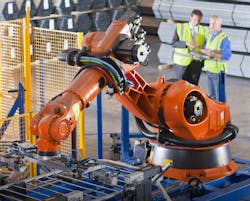Isolation—An Integral Component in Robotics Motion Control (.PDF Download)
The transition to Industry 4.0 has accelerated the adoption of robots, cobots (cooperative robots that interact with humans in a common workspace), and other advanced machines on the factory floor to generate higher levels of productivity. In addition, new energy standards are demanding ever-increasing levels of power efficiency.
Together, these new requirements drive new design challenges in several areas, including networked communications, distributed sensing, and precision motion control.
The Motor and its Control System: Critical Factors in Energy Reduction
A current-generation factory work cell, such as the industrial robot shown in Figure 1, uses multiple electric motors. In fact, electric motors account for around two-thirds of industrial power consumption according to some studies. Thus, it’s no surprise that developing power-efficient motors and control strategies is of paramount importance.
1. Robots and other Factory 4.0 applications require both precision motor control and low energy consumption. (Source: Analog Devices)

